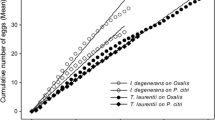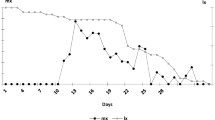Abstract
Life history and reproductive parameters of the generalist predatory mite Euseius (Amblyseius) finlandicus (Oudemans) were studied in the laboratory at 25 ± 1°C, with a 16L:8D photoperiod and 60 ± 15% RH, to investigate its response to different food sources: an eriophyid mite Aceria sp., tulip pollen Tulipa gesnerana L., and two-spotted spider mite Tetranychus urticae Koch. Total developmental time of the immature stages was the shortest on eriophyid mites, followed by pollen, and then spider mites. Fecundity was highest on pollen (43.69 eggs; 1.63 eggs/female/day), then eriophyid mites (39.73 eggs; 1.37 eggs/female/day) and lowest on spider mites (18.16 eggs; 0.80 eggs/female/day). Intrinsic rate of increase (r m), net reproductive rate (R o) and finite rate of increase (λ) followed the same pattern [pollen (0.168, 27.96 and 1.183, respectively), eriophyid mites (0.153, 20.81 and 1.167), spider mites (0.110, 9.44 and 1.119)]. Mean generation time (days) was the shortest on pollen (19.90), followed by eriophyid mites (20.02), and then spider mites (20.59). Average spider mite larvae consumed by E. finlandicus during immature stages were 9.18 for males and 11.85 for females. Adult E. finlandicus females consumed an average of 166.38 spider mite protonymphs during adult stage compared to an average of 66.55 by males. The number of prey protonymphs consumed per day by females was highest in the oviposition period, lower in the pre-oviposition period and the lowest in the post-oviposition period. The eriophyid mite as a prey recorded the shortest developmental time, while pollen as food recorded the highest oviposition rate in E. finlandicus. The potential of this predator as a biocontrol agent against T. urticae is discussed.
Similar content being viewed by others
References
Abou-Setta, M.M. andChilders, C.C. 1987. Biology of Euseius mesembrinus (Acari: Phytoseiidae) life-tables on ice plant pollen at different temperatures with notes on behaviour and food range. Exp. Appl. Acarol. 3: 123-130.
Birch, L.C. 1948. The intrinsic rate of natural increase of an insect population. J. Animal Ecol. 17: 15-26.
Chant, D.A. 1959. Phytoseiid mites (Acarina: Phytoseiidae). Part I. Bionomics of seven species in southeastern England. Part II. A taxonomic review of the family Phytoseiidae, with descriptions of 38 new species. Can. Ent. 12(Suppl.): 1-166.
Chi, H. 1997. Computer program for the age-stage, two-sex life table analysis. National Chung Hsing University, Taichung, Taiwan.
Collyer, E. 1964. The effect of an alternative food supply on the relationship between two Typhlodromus species and Panonychus ulmi (Koch) (Acarina). Entomol. Exp. Appl. 7: 120-124.
Dicke, M.Sabelis, M.W.Jong, M.D. andAlers, M.P.T. 1990. Do phytoseiid mites select the best prey species in terms of reproductive success? Exp. Appl. Acarol. 8: 161-173.
Duso, D. 1992. Biological control of the Tetranychid mites in peach orchards of northern Italy: role of Amblyseius andersoni (Chant) and Amblyseius finlandicus (Oud.) (Acari: Phytoseiidae). Acta Phytophathol. Entomol. Hungarica 27: 211-217.
Gagnon, J.Roth, J.M.Carroll, M.Haycock, K.A.Plamondon, J.Feldman, D. S. andSimpsoon, J. 1989. Super ANOV accessible general linear modelling. Abacus Concepts, Berkeley, CA.
Genini, M.Klay, A.Delucchi, V.Baillod, M. andBaumgärtner, J. 1983.Les espéces de Phytoseiides (Acarina: Phytoseiidae) dans les vergers de pommier en Suisse. Mitt. Schweiz. Entomol. Ges. 56: 45-56.
Grout, T.G. andRichards, R.I. 1992. The dietary-effect of windbreak pollens on longevity and fecundity of a predacious mite Euseius addoensis addoensis (Acari, Phytoseiidae) found in citrus orchards in South Africa. Bull. Entomol. Res. 82: 317-320.
Gruys, P. 1982. Hits and misses: the ecological approach to pest control in orchards. Ent. Exp. Appl. 31: 70-87.
Helle, W. andSabelis, M.W. 1985. Spider Mites: Their Biology, Natural Enemies and Control, Vol. 1B, 458 pp Elsevier, Amsterdam.
Karg, W.Mack, S. andBair, B. 1987. Advantages of oligophagous predatory mites for biological control. Bull. SROP 10: 66-73.
Kostiainen, T. andHoy, M.A. 1994. Egg-harvesting allows large scale rearing of Amblyseius finlandicus (Acari: Phytoseiidae) in the laboratory. Exp. Appl. Acarol. 18: 155-165.
Kropczynska, D. andTuovinen, T. 1988. Occurrence of Phytoseiid mites (Acari: Phytoseiidae) on apple trees in Finland. Annal. Agric. Fenniae 27: 305-314.
McMurtry, J.A. 1982. The use of phytoseiids for biological control: progress and future prospects. In: Recent Advances in Knowledge of the Phytoseiidae, M.A. Hoy (ed.), pp. 23-48. University of California Press, Berkeley.
McMurtry, J.A. 1983. Phytoseiid predators in orchard systems: a classical biological control success story. In: Biological Control of Pests by Mites, M.A. HoyG.L. Cunningham andL. Knutson (eds), pp. 21-26. Division of Agricultural Sciences Publication 3304, University of California, Berkeley, CA.
McMurtry, J.A. 1985. Citrus. In Spider Mites: Their Biology, Natural Enemies and Control, W. Helle andM.W. Sabelis (eds), Vol. 1B, pp. 339-347. Elsevier, Amsterdam.6
McMurtry, J.A. andCroft, B.A. 1997. Life-styles of phytoseiid mites and their role in biological control. Ann. Rev. Entomol. 42: 291-321.
McMurtry, J.A. andRodriquez, J. 1987. Nutritional ecology of phytoseiid mites. In: Nutritional Ecology of Insects, Mites and Spiders, F. Slansky andJ. Rodriquez (eds.), 1016 pp. Wiley & Sons, New York.
Ramakers, P.M.J. 1995. Biological control using oligophagous predators. In: Thrips Biology and Management, B.L. Parkers (ed.), pp. 225-230. Plenum Press, New York.
Schausberger, P. 1991.Vergleichende Untersuchungen zum Lebensverlauf, die Erstellung von Lebenstafeln und die Vermehrungskapazität von Amblyseius aberrans Oud. und A. finlandicus Oud. (Acari: Phytoseiidae). Pflanzenschutzber 52: 53-71.
Schausberger, P. 1992. Comparative investigations on the effect of different foods on development and reproduction of Amblyseius aberrans Oud. and A. finlandicus Oud. (Acarina, Phytoseiidae). J. Appl. Entomol. 113: 476-486.
Schausberger, P. 1997. Inter-and intraspecific predation on immatures by adult females in Euseius finlandicus, Typhlodromus pyri and Kampimodromus aberrans (Acari: Phytoseiidae). Exp. Appl. Acarol. 21: 131-150.
Schausberger, P. 1998. Survival, development and fecundity in Euseius finlandicus, Typhlodromus pyri and Kampimodromus aberrans (Acari, Phytoseiidae) feeding on the San Jose scale Quadraspidiotus perniciosus (Coccina, Diaspididae). J. Appl. Entomol. 122: 53-56.
Schausberger, P. 1999. Juvenile survival and development in Euseius finlandicus, Typhlodromus pyri and Kampimodromus aberrans (Acari: Phytoseiidae) feeding on con-and heterospecific immatures. Exp. Appl. Acarol. 23: 297-307.
Schausberger, P. andCroft, B.A. 1999. Activity, feeding, and development among larvae of specialist and generalist phytoseiid mite species (Acari: Phytoseiidae). Environ. Entomol. 28: 322-329.
Sechser, B.Thueler, P. andBachmann, A. 1984. Observations on population levels of the European red mite (Acari: Tetranychidae) and associated arthropod predatory complexes in different spray programmes over a 5-year period. Environ. Entomol. 13: 1577-1582.
Van de Vrie, M. 1975. Some studies on the predator-prey relationship in Amblyseius (T.) potentillae Garmans, A. finlandicus Oud. and Panonychus ulmi (Koch) on apple. Parasitica 31: 43-44.
Zhang, Z.Q. andCroft, B.A. 1994. A comparative life-history study of immature Amblyseius fallacis, A. andersoni, Typhlodromus occidentalis and T. pyri (Acari: Phytoseiidae) with a review of larval feeding patterns in the family. Exp. Appl. Acarol. 18: 631-657.
Author information
Authors and Affiliations
Rights and permissions
About this article
Cite this article
Abdallah, A.A., Zhang, ZQ., Masters, G.J. et al. Euseius Finlandicus (Acari: Phytoseiidae) as a Potential Biocontrol Agent against Tetranychus Urticae (Acari: Tetranychidae): Life History and Feeding Habits on Three Different Types of Food. Exp Appl Acarol 25, 833–847 (2001). https://doi.org/10.1023/A:1020431531446
Issue Date:
DOI: https://doi.org/10.1023/A:1020431531446




